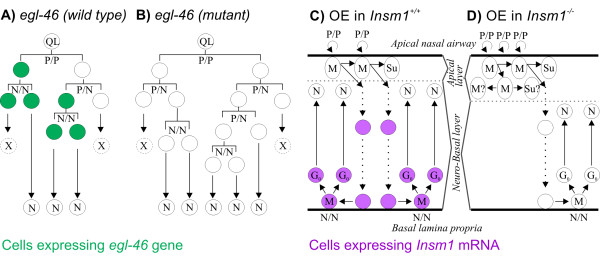Figure 10.
Phenotypic similarities between egl-46 mutant nematodes and Insm1 knockout mouse OEs suggest a conserved role for both orthologs in promoting terminal, neuronogenic progenitors. (A) In C. elegans, EGL-46 (green) is expressed in late neuronal progenitors destined to terminally divide to produce two neurons (N/N divisions; some of these daughters undergo programmed cell death and are labeled X) and transiently in the nascent neurons. EGL-46 is not expressed in early neural progenitors, which divide to generate more progenitors (P/P or P/N divisions). (B) In egl-46 mutants, cells that would normally terminally divide instead undergo proliferative divisions, thus delaying terminal, neuronogenic divisions. (C) In the embryonic mammalian OE early progenitor cells divide apically (P/P) to produce more progenitors and/or sustentacular cells (which do not display markers of differentiation until later stages). Some of the apically produced cells migrate to the basal lamina, where they divide again to produce neurons (some of these basal progenitors undergo N/N divisions). By E14.5 apical and neuro-basal cells are distinguished based on their nuclear morphology, which is elongate in the apical layer. By E16.5, apical progenitors are believed to produce sustentacular cells, basal progenitors are believed to produce developing neurons, and these populations are believed to be increasingly separate, with diminishing migration from the apical to the basal population. Cells known to express Insm1 are indicated in purple. (D) Insm1-/- OEs contain more apical and presumed proliferative progenitors and fewer basal, terminally dividing and presumed neuronogenic progenitors, a phenotype similar to that caused by egl-46 mutation in nematodes (compare (B) and (D)). This leads to a thicker apical layer (delineated by a dashed line in (C, D)) and a thinner neuro-basal layer. In contrast to egl-46 mutant nematodes, Insm1-/- mouse embryonic OEs display fewer neurons, and at a later stage increased apoptosis. M represents cells in mitosis, N neurons, Su sustentacular cells and QL a neuroblast of the nematode lineage.

